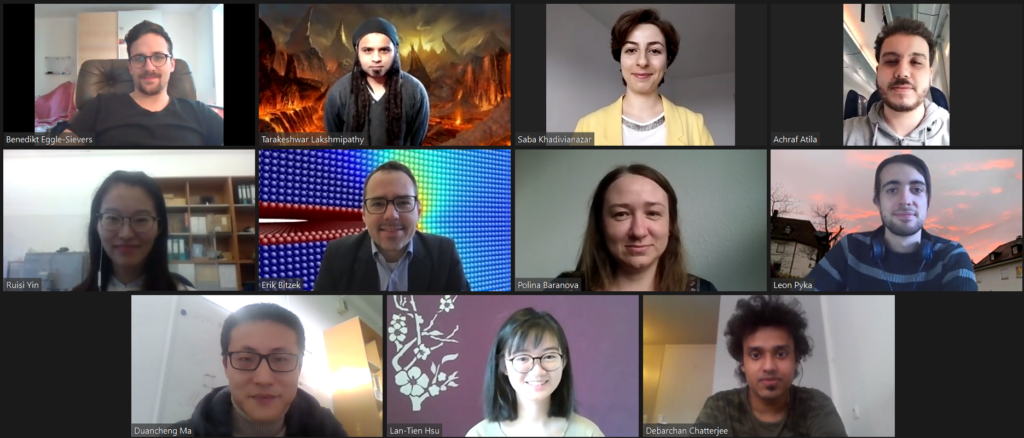Modelling & Simulation

[since 1.9.2021 at MPI Düsseldorf]
The materials modeling group, headed by Prof. Erik Bitzek, conducts research into the elementary defects of the crystalline lattice (dislocations, cracks, interfaces, vacancies) and on how the organization and interaction of these defects influence the mechanical properties of metallic materials. The groups activity also includes the modeling of mechanical properties of amorphous systems, like silica and bulk metallic glasses. In all these studies, atomistic simulations and density functional calculations are use to obtain detailed information on defect properties and on the mechanisms that lead to deformation and failure.
The focus of our research is to provide qualitative insights as well as quantitative information on the deformation processes at work at the atomic scale. These findings lead to better understanding and interpretation of experimental results, whilst simultaneously helping in the development of robust and reliable models for the prediction of deformation behavior of materials. Insights from atomistic simulations are used in our group to develop multiscale models like crystal plasticity frameworks with the finite element method (FEM) and the fast Fourier transform (FFT) method. Such models bridge various length scales and facilitate the simulation of complex forming processes.
The group collaborates closely with the Institute of Materials Simulation (WW8) on multiscale modeling, and with the Computer Chemistry Center (CCC) on the density functional calculations. It is also a part of the Cluster of Excellence Engineering of Advanced Materials (EAM) and the Central Institute of Scientific Computing (ZISC).
It participates in the Collaborative Research Center SFB/Transregio 103 From Atoms to Turbine Blades, the Priority Programs SPP1594 Topological Engineering of Ultrastrong Glasses and SPP1466 Life as well as the Graduiertenkolleg 1869 “In-Situ Microscopy with Electrons, X-rays and Scanning Probes”, the EU project iSTRESS and in the research network Mechanics of Nano-objects MECANO. Erik Bitzek was furthermore recently awarded an ERC Consolidator Grant for his project on the Microscopic Origins of Fracture Toughness (microKIc).
Prof. Dr.-Ing. Erik Bitzek, Privatdozent
Department of Materials Science and Engineering
Chair of General Materials Properties
- Email: erik.bitzek@fau.de
Achraf Atila, M. Sc.
Department of Materials Science and Engineering
Chair of General Materials Properties
- Phone number: +49 9131 85-27486
- Email: achraf.atila@fau.de
Benedikt Eggle-Sievers, M.Sc.
Department of Materials Science and Engineering
Chair of General Materials Properties
- Phone number: +49 9131 85-27486
- Email: benedikt.eggle-sievers@fau.de
Saba Khadivianazar
Department of Materials Science and Engineering
Chair of General Materials Properties
- Phone number: +49 9131 85-27486
- Email: saba.khadivianazar@fau.de
Amorphe, anorganische Materialien können extrem hohe Festigkeiten aufweisen, leiden aber in der Regel unter sehr begrenzter Bruchzähigkeit. In den letzten Jahren ist die Nachfrage nach ultrastarken, schadensresistenten Gläsern gestiegen. Eine signifikante Erhöhung der Zähigkeit für neue glasartige Materialien wird jedoch nur mit einem neuen Maß an konzeptionellem Verständnis der zugrundeliegenden Verformungsmechanismen und ihrer Beziehung zur lokalen Struktur und Netzwerktopologie möglich sein.
→ Mehr Informationen
Die Erforschung des Materialversagens und dessen Zusammenhang mit der Mikrostruktur eines Materials steht im Mittelpunkt der Materialwissenschaften. Ob eine beanspruchte Komponente spröde oder duktil bricht, wird durch die Fähigkeit der Materialien bestimmt, elastische Energie in plastische Arbeit umzuwandeln. Die plastische Energie-Dissipation während dem Bruch wird durch die Erzeugung und Bewegung von Versetzungen am Riss bestimmt. Wir verwenden groß angelegte, vollständig dreidimensionale atomistische Simulationen, um einzelne Risse und das Zusammenspiel von statischen und sich ausbreitenden Rissen mit Versetzungen, Korngrenzen und anderen Elementen der Mikrostruktur zu untersuchen.
→ Mehr Informationen
Die plastische Verformung von Metallen wird durch die Bewegung von Versetzungen getragen. Trotz ihrer Bedeutung für Prozesse mit hoher Dehnrate wie Hochgeschwindigkeitsschneiden sind die Parameter, die die Bewegung von Versetzungen bei hohen Geschwindigkeiten bestimmen, noch nicht vollständig verstanden. In diesem Projekt untersuchen wir die beschleunigte Bewegung von Versetzungen in verschiedenen kfz-Metallen bei unterschiedlichen Temperaturen und Belastungen sowie deren Wechselwirkung mit Hindernissen.
→ Mehr Informationen
Amorphous, inorganic materials can show extremely high strengths but usually suffer from very limited fracture toughness. The recent years have seen a rising The glide of dislocations and their interaction with obstacles determines the plastic deformation of metals. Structural materials usually consist of many crystallites (“grains”) of different orientations. The boundaries between these grains are strong obstacles to the propagation of slip.
→ Mehr Informationen
The mechanical properties of metal structures change dramatically when their characteristic length scale is of the order of micrometers of below. Nanosized metallic wires, pillars, particles or thin films show for example an increased yield stress (the so-called “smaller is stronger” effect), and changes in their elastic response compared to their bulk counterparts.
→ Mehr Informationen
Nanocrystalline materials are characterized by typical grain sizes below 100 nm. These materials exhibit strengths up to ten times higher than that of conventional polycrystalline materials, whilst most of them simultaneously show a significant decrease in ductility. A detailed understanding of the deformation and failure mechanisms is imperative to controlling and tailoring the mechanical properties of this new class of materials. Here, atomistic simulations provide a unique way to study the dislocation and grain boundary processes involved in plastic deformation.
→ Mehr Informationen
The performance and lifetime of small-scale materials and devices (nanostructured materials, thin films, MEMS, …) are critically influenced by intrinsic stresses resulting from manufacturing. However, the established techniques for micron-scale measurements of residual stresses still have strong limitations. The goal of the EU-project “Pre-standardisation of incremental FIB micro-milling for intrinsic stress evaluation at the sub-micron scale” (iSTRESS) was to develop an innovative protocol for the analysis of residual stress distribution on a (sub)micron-scale.
→ Mehr Informationen
Nickelbasis-Superlegierungen weisen außergewöhnliche mechanische Eigenschaften bei hohen Temperaturen auf und sind Schlüsselmaterialien für Turbinenschaufeln in Strahltriebwerken und Gasturbinen. Da die mechanischen Eigenschaften dieser Superlegierungen stark von der Mikrostruktur abhängen, spielen die Wechselwirkungen von Versetzungen in den γ-Kanälen mit den γ‘-Ausscheidungen eine wichtige Rolle bei der herausragenden Festigkeit dieser Legierungen bei hohen Temperaturen.
→ Mehr Informationen
High entropy alloys (HEAs) are chemically complex single-phase alloys with simple crystal structure. They are a novel class of alloy systems with five or more elements at near equiatomic composition with the potential of achieving non-incremental advances in mechanical properties. It is assumed that the high configurational entropy in these alloys stabilizes the single phase despite a significant energetic cost, as the disordered arrangement of atoms implies large atomic-scale lattice distortions.
→ Mehr Informationen
Interfaces and dislocation-interface interactions play an important role for development of alloys with improved mechanical properties. Many alloys, however, are characterized by the presence of complex intermetallic phases. Examples, which are currently investigated at our institute, are die-castable Mg alloys for automotive applications.
→ Mehr Informationen
Der Mikro-Freischwing-Biegetest wird häufig auf Mikro-Skala-Proben für Bruchzähigkeit angewendet. Durch die geringe Größe der Proben bestehen sie in der Regel aus einkristalline Materialien, bei denen die zugrundeliegende Verformung stets anisotrop ist. Dennoch wird meist die isotrope Theorie angewendet, um die Bruchzähigkeit in Experimenten zu bewerten.
→ Mehr Informationen
Metallische Nanostrukturen erhalten derzeit viel Aufmerksamkeit aufgrund ihrer oft überlegenen mechanischen Eigenschaften im Vergleich zu Schüttgütern [1]. In ähnlicher Weise haben nanokristalline und insbesondere nanoverstärkte Metalle in letzter Zeit wegen ihrer hohen Streckgrenze großes Interesse erregt [2].
→ Mehr Informationen
Risse sind für die Festigkeit eines Materials entscheidend. Die klassische Annahme ist, dass ein halb so großer Bauteil nur die Hälfte an Last tragen kann. Doch ein Riss der zur Hälfte durch ein Bauteil geht reduziert diese ertragbare Last auf einen Bruchteil. Dabei erzeugt der Riss durch seine scharfe und spitze Geometrie eine Spannungsüberhöhung an seiner Front, welche das Material an der Rissspitze versagen lässt. Dieses Versagen setzt sich durch das ganze Bauteil hindurch fort und führt zum Versagen. Spröde Materialien werden daher selbst durch mikroskopisch kleine Risse massiv geschwächt, wohingegen duktile Materialien den Riss abstumpfen lassen.
→ Mehr Informationen
- , , , , , , , , , , , , :
Microscopic Deformation Modes and Impact of Network Anisotropy on the Mechanical and Electrical Performance of Five-fold Twinned Silver Nanowire Electrodes
In: ACS nano (2020), Article No.: acsnano.0c06480
ISSN: 1936-0851
DOI: 10.1021/acsnano.0c06480 - , , , , , , :
Assessment and optimization of the fast inertial relaxation engine (FIRE) for energy minimization in atomistic simulations and its implementation in LAMMPS
In: Computational Materials Science 175 (2020), Article No.: 109584
ISSN: 0927-0256
DOI: 10.1016/j.commatsci.2020.109584 - , , , , , , , , , :
Combining Experiments and Atom Probe Tomography-Informed Simulations on γ′ Precipitation Strengthening in the Polycrystalline Ni-Base Superalloy A718Plus
In: Advanced Engineering Materials (2020)
ISSN: 1438-1656
DOI: 10.1002/adem.202000149 - , , , , , , , , :
In-situ observation of the initiation of plasticity by nucleation of prismatic dislocation loops
In: Nature Communications 11 (2020), Article No.: 2367
ISSN: 2041-1723
DOI: 10.1038/s41467-020-15775-y - , , , :
On the presence of nanoscale heterogeneity in Al70Ni15Co15 metallic glass under pressure
In: Journal of Non-Crystalline Solids 550 (2020), Article No.: 120381
ISSN: 0022-3093
DOI: 10.1016/j.jnoncrysol.2020.120381




